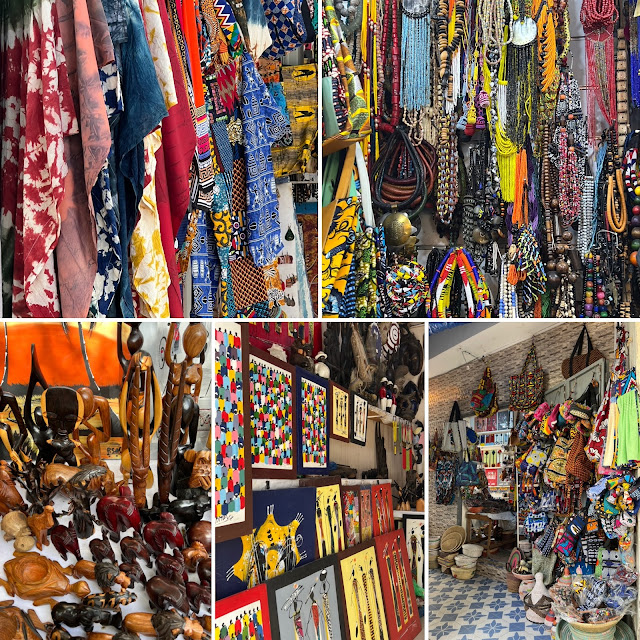West Africa Series: Senegal
A Kaleidoscopic Journey Through Dakar
A Kaleidoscopic Journey Through Dakar
As I set foot in Dakar, Senegal’s vibrant capital, I found myself immersed in a city that effortlessly marries modernity with the charm of its colonial past. The journey began at the train station, where the French-influenced architecture unfolded, setting the tone for a delightful exploration.
Wandering through Independence Square, I was captivated by the juxtaposition of modern commercial buildings and colonial structures that seemed frozen in time. The Presidential Palace, standing proudly since 1906, exuded colonial elegance, its facade guarded by the iconic Spahi in their distinctive red-and-blue uniforms, a symbol of Senegal’s rich history.
In a predominantly Muslim country, the presence of the Our Lady of Victories Cathedral added an intriguing layer. Its French-inspired architecture, adorned with a captivating fresco and African artworks, stood as a testament to religious coexistence.
Venturing beyond the city center revealed a striking dichotomy – upscale homes juxtaposed with impoverished residential areas, offering a glimpse into the city's diverse social fabric. Passing through the historic Medina, or Old Town, along the coastal road heightened the contrast, showcasing Dakar's multifaceted identity. Amidst the landscape, the ancient baobab tree stood proudly, a symbol of national pride. Dakar's closed university, still recovering from a fire, hinted at the city's resilience.
As I ventured further, the African Renaissance Monument loomed large—a towering symbol constructed by North Korea. Its imposing figures, set against a backdrop of unfinished homes, offered a striking commentary on art, politics, and global influences. Not far from the African Renaissance Monument, we found the “Mosque de La Divinite.” It stands as another testament to Dakar's diverse religious landscape.
Driving along the coastal road, we passed a sprawling fitness park that stretched for an impressive 2 kilometer's. Nestled against the backdrop of the Atlantic Ocean, the park offered a perfect blend of outdoor exercise and breathtaking sea views. I saw locals engaging in various activities, from using the fitness equipment to jogging along the scenic promenade against the sound of the crashing waves. Then I began to understand why the emergence of surfing as a trendy sport in Senegal.
Continuing along the coastal road, the scenery unfolded to reveal a charming fishing village. Rows upon rows of colorful boats painted a vivid picture against the azure waters. Each boat seemed to tell a story of the daily endeavors of the local fishermen, their livelihoods intricately tied to the rhythm of the ocean. We found the Soumbedioune Handicraft Village nearby offering a treasure trove of wooden artifacts, jewelry, carvings, leather goods, and fabrics. Amidst the city’s cultural tapestry, the markets stole the show.
 |
| Soumbedioune Handicraft Village |
Dakar, offered me a sensory overload like no other, and at the heart of this bustling city, the markets stood out as kaleidoscopes of culture, colors, and culinary wonders. My quest for the renowned Kelmer Market, visited by the legendary Anthony Bourdain, became an adventure through a labyrinth of market stalls and established stores.
As I meandered through the narrow streets, the vibrant markets unfolded before me like a living tapestry. Each corner boasted a riot of colors, with vendors passionately hawking their wares, from fabrics, handcrafted jewelry to spices that tantalized the senses. The air was thick with the aroma of exotic spices and the lively chatter of locals negotiating deals.
The journey was not just about finding Kelmer Market but about immersing myself in the vibrant tapestry of Dakar's daily life. Locals shared stories of their creations, and every purchase felt like a connection to the soul of the city. The markets were a living, breathing testament to Senegal's diverse cultural influences, from French colonial heritage to the indigenous traditions that shaped its identity.
Finally, when I arrived at Kelmer Market, it was a culmination of sensory experiences. The market echoed with the lively banter of vendors and the distinct aroma of traditional Senegalese dishes wafting through the air. Stalls were adorned with an array of goods, from vibrant fabrics to intricately woven baskets.
As I explored Kelmer Market, I couldn't help but reflect on Anthony Bourdain's appreciation for the culinary diversity the world has to offer. The food stalls in Kelmer Market lived up to the hype. From the iconic Thieboudienne to flavorful street snacks, each bite was a celebration of Senegal's culinary artistry.
In the end, my journey through Dakar's markets was not just about ticking a famous destination off my list. It was about embracing the spirit of exploration, immersing myself in the vibrant tapestry of local life, and savoring the unique flavors that make Dakar a destination like no other. The colorful markets became more than waypoints; they became the soul of my Senegalese adventure, leaving me with indelible memories of a city that dances to the rhythm of its markets.
PHOTO GALLERY
 |
| The dome of Our Lady of Victories Cathedra |
 |
| Train Station |
 |
| Baobab Tree |
 |












Comments
Post a Comment